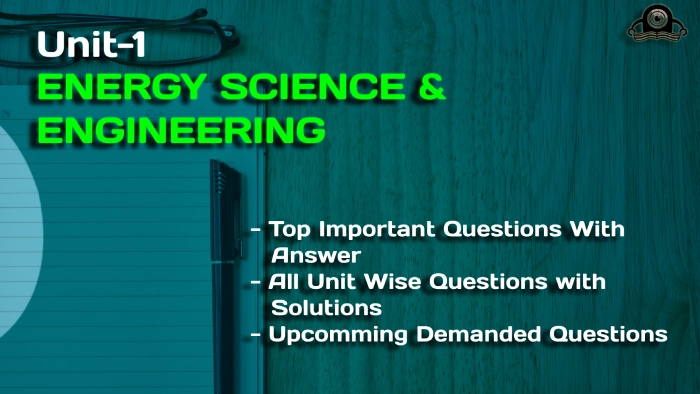Hello, Bachelor exam family! Today we provide all the important questions in Energy Science and Engineering Unit 1 (Energy and its Usage).
Dudes 🤔.. You want more useful details regarding this subject. Please keep in mind this as well. Important Questions For Energy science and engineering : *Unit-01 *Unit-02 *Unit-03 *Unit-04 *Unit-05 *Short-Q/Ans *Question-Paper with solution 21-22
Q1. Discuss in brief superconducting magnetic energy storage (SMES).
Ans.
- 1. Superconducting magnetic energy storage (SMES) devices store energy in a magnetic field generated by direct current flowing through a superconducting coil.
- 2. A superconducting coil in a cryogenic enclosure, an electronic converter to match the DC power in the coil to the AC on the grid, and an electronic switch to control the flow of current into and out of the coil compose a SMES system.
- 3. A DC voltage is applied to the superconducting coil, causing the current across the coil to grow.
- 4. When the current reaches its operating value, an electronic switch disconnects the DC power and short-circuits the coil. Because the coil has no resistance, the electricity continues to circulate without interruption and without producing heat.
- 5. The switch is opened to release the stored energy, and the coil discharges via the converter, producing AC power that may be sent into the grid.
- 6. Their main benefit over other types of energy storage is their extremely fast reaction time and capacity to offer high power for short periods of time.
- 7. SMES systems can counterbalance abrupt fluctuations in demand for applications where even the smallest interruptions are unacceptable since they can be turned on with virtually no time delay.
Q2. Discuss the application and economic aspects of fuel cells.
Ans.
A. Applications of Fuel Cell: Various applications of fuel cells are as follows:
i. Portable Applications: These include:
- 1. Portable power generators,
- 2. Consumer electronics,
- 3. Portable military equipment, etc.
ii. Transportation Applications: These include :
- 1. Auxiliary power units,
- 2. Light traction vehicles,
- 3. Marine propulsion, etc.
iii. Stationary Applications: These include:
- 1. Distributed power generation,
- 2. Combined heat and power,
- 3. Back up power supply, etc.
B. Economic Aspects of Fuel Cells:
- 1. Fuel cells, as a novel energy technology, have yet to make a big impact on the energy industry. The key hurdles in commercializing fuel cells are cost, durability, and reliability.
- 2. The manufacturing life cycle and value chain indicate the manufacturing technique and fuel cycle cost.
- 3. The cost of manufacturing includes the design, materials, component fabrication, assembly, labor, and equipment capital necessary for the entire assembly of custom-built and commercially produced fuel cells.
- 4. The most expensive components of the system were the stack, air management, fuel management, and thermal management. The assembly and balance of the stack system accounted for 14% of the total cost.
- 5. Most assessments on existing fuel cell costs are clearly based solely on stack production costs, with little consideration given to repair and maintenance costs. However, repair and maintenance costs are required for stack service and end-user approval.
Q3. Define refrigeration. State the application of refrigeration.
Ans. A. Refrigeration :
- 1. Refrigeration is the process of chilling or removing heat from a system.
- 2. It is the study of generating and sustaining temperatures lower than those of the surrounding atmosphere, i.e., the removal of heat from a substance under controlled conditions.
- 3. The equipment used to keep the system at a low temperature is known as a refrigerating system, and the system that is kept at a low temperature is known as a refrigerated system.
B. Applications of Refrigeration:
- 1. Making of ice.
- 2. It is used in transportation of food at a required temperature.
- 3. It is used in industrial and comfort air conditioning.
- 4. It is used in manufacturing and treatment of metals.
- 5. It is used in processing food products and beverages.
Q4. Classify the internal combustion engine.
Ans. Internal combustion engines can be classified as follows:
i. According to Basic Engine Design:
- 1. Reciprocating engine, and
- 2. Rotary engine.
ii. According to Working Cycle:
- 1. Otto cycle, and
- 2. Diesel cycle.
iii. According to the Number of Strokes:
- 1. Four-stroke engine, and
- 2. Two-stroke engine.
iv. According to Fuel Employed:
- 1. Gasoline or petrol engine,
- 2. Diesel engine,
- 3. LPG engine, and
- 4. CNG engine.
v. According to Fuel Supply and Mixture Preparation :
- 1. Carbureted type, and
- 2. Injection type.
vi. According to the Method of Ignition:
- 1. Battery ignition, and
- 2. Magneto ignition.
vii. According to the Method of Cooling:
- 1. Water-cooled engine, and
- 2. Air-cooled engine.
viii. According to Cylinder Arrangement:
- 1. Inline engine,
- 2. V-engine, and
- 3. Radial engine.
Q5. Describe the basic terminology used in internal combustion engines.
Ans. Terms used in internal combustion engines are as follows:
i. Cylinder Bore: It is the nominal inner diameter of the working cylinder. It is represented by D.
ii. Piston Area: It is the area of a circle of diameter equal to the cylinder bore.
iii. Stroke: The stroke is the distance traveled by a piston from the top dead center to the bottom dead center.
iv. Bottom Dead Centre (BDC): It is the dead center when the piston is closest to the crankshaft or when the piston is at its lowest position towards the crank end side of the cylinder.
v. Top Dead Centre (TDC): It is the dead center when the piston is farthest from the crankshaft or when the piston is at its highest point towards the cover end side of the cylinder.
vi. Displacement Volume (or Piston Swept Volume):
1. This is the volume swept by the piston moving from one dead center to another.
2. It is calculated as the product of piston area and stroke.



vii. Clearance Volume: Clearance volume is the volume contained in the cylinder above the top of the piston when the piston is at the top dead center.
viii. Cylinder Volume:
1. The sum of swept volume and clearance volume is known as cylinder volume.
ix. Compression Ratio :
1. This is defined as the ratio of the volume at the start of compression to the volume at the end.






Q6. How internal combustion engines work?
Ans. Working of internal combustion four-stroke spark ignition engine is as follows:
a. Suction Stroke:
- 1. The suction stroke (Fig.) begins when the piston is at the top dead centre and ready to move to the bottom dead centre.
- 2. During this stroke, the inlet valve is open and the outlet valve is closed.
- 3. The charge is a mixture of air and fuel drawn into the cylinder by the suction caused by the piston’s downward motion.
- 4. At the end of the suction stroke, both the inlet and outlet valves are closed.
b. Compression Stroke:
- 1. The fresh charge introduced into the cylinder during the suction stroke is compressed during the piston’s return stroke.
- 2. In this stroke, both the inlet and outlet valves remain closed.
- 3. The spark plug ignites the mixture of air and fuel just before the end of the compression stroke.
- 4. When the piston is nearly at the top dead centre, it begins to burn. During the burning process, the chemical energy of the charge is transformed into perceptible energy, causing a temperature increase of around 2000 °C and an increase in pressure.
c. Expansion or Working Stroke:
- 1. Because of the high pressure, burning gases force the piston to the bottom dead center, resulting in power during this stroke.
- 2. Both pressure and temperature decrease during this stroke.
- 3. In this stroke, both valves remain closed.
d. Exhaust Stroke:
- 1. In this stroke, the inlet valve is closed and the outlet valve is open.
- 2. Burnt gases escape from the cylinder when the piston moves from the bottom dead center to the top dead center.
- Image page no. = 1-25G



Short Question | Long Question | Important Question | Quantums
Energy science and engineering Important Links:
| Label | Link |
|---|---|
| Subject Syllabus | Syllabus |
| Short Questions | Short-question |
| Important Unit-1 | Unit-1 |
| Important Unit-2 | Unit-2 |
| Important Unit-3 | Unit-3 |
| Important Unit-4 | Unit-4 |
| Important Unit-5 | Unit-5 |
| Question paper – 2021-22 | 2021-22 |
AKTU Important Links | Btech Syllabus
| Link Name | Links |
|---|---|
| Btech AKTU Circulars | Links |
| Btech AKTU Syllabus | Links |
| Btech AKTU Student Dashboard | Student Dashboard |
| AKTU RESULT (One VIew) | Student Result |
Important Links-Btech (AKTU) | Energy science and engineering Syllabus
| Label | Links |
|---|---|
| Btech Information | Info Link |
| Btech CSE | CSE-LINK |
| Quantum-Page | Link |
| Energy science and engineering Syllabus | Syllabus-Energy science and engineering |

4 thoughts on “Unit 1 Energy Science and Engineering – Energy and Its Usage for AKTU B.Tech”